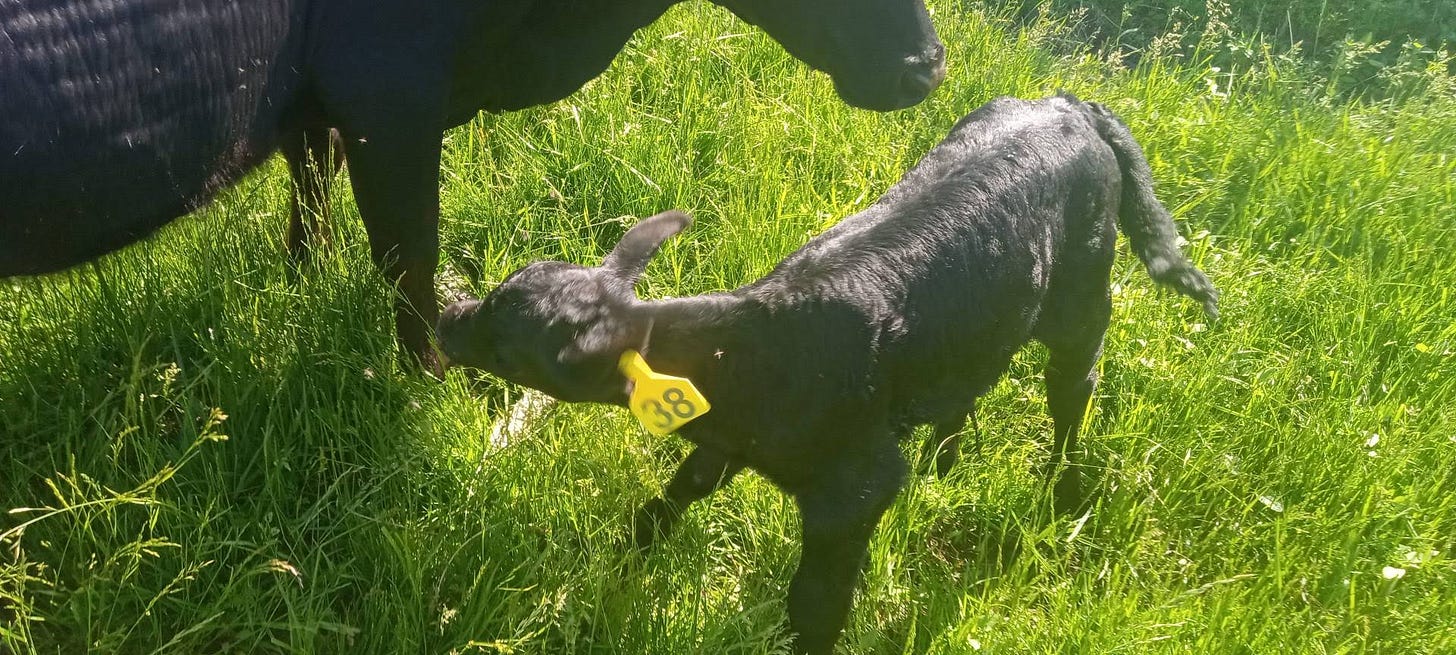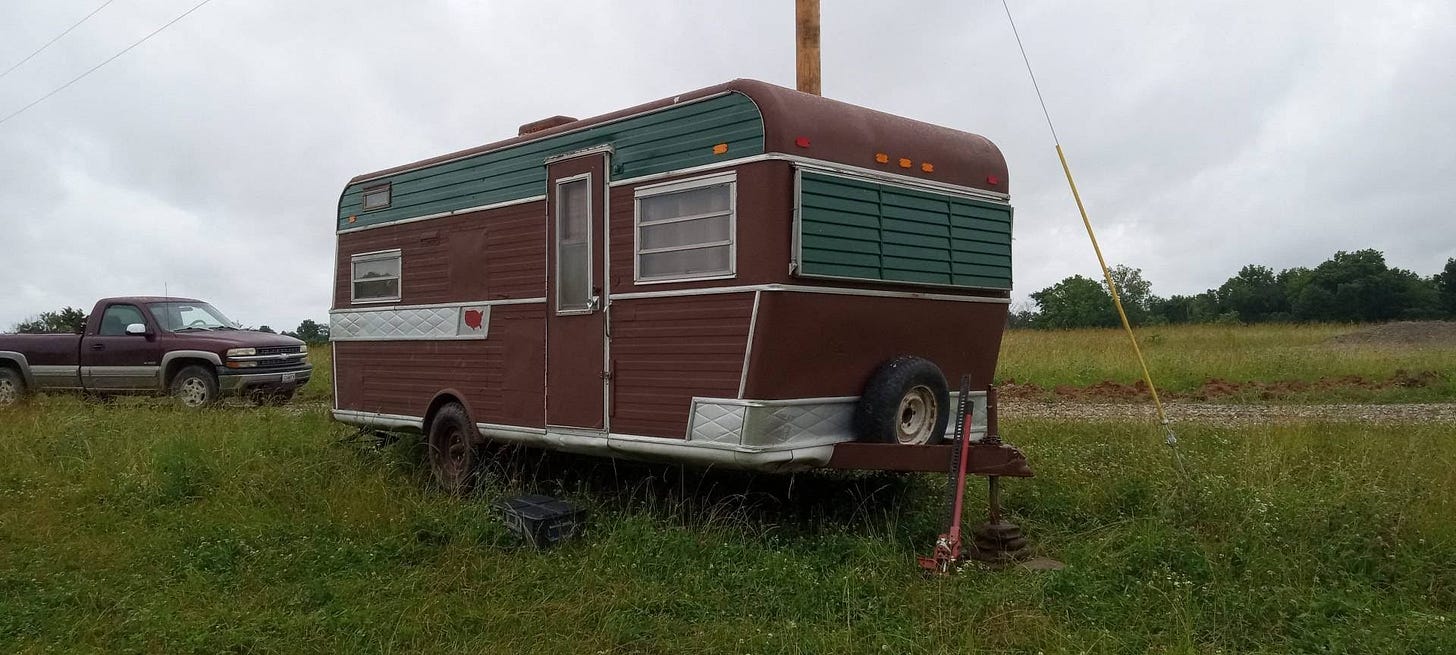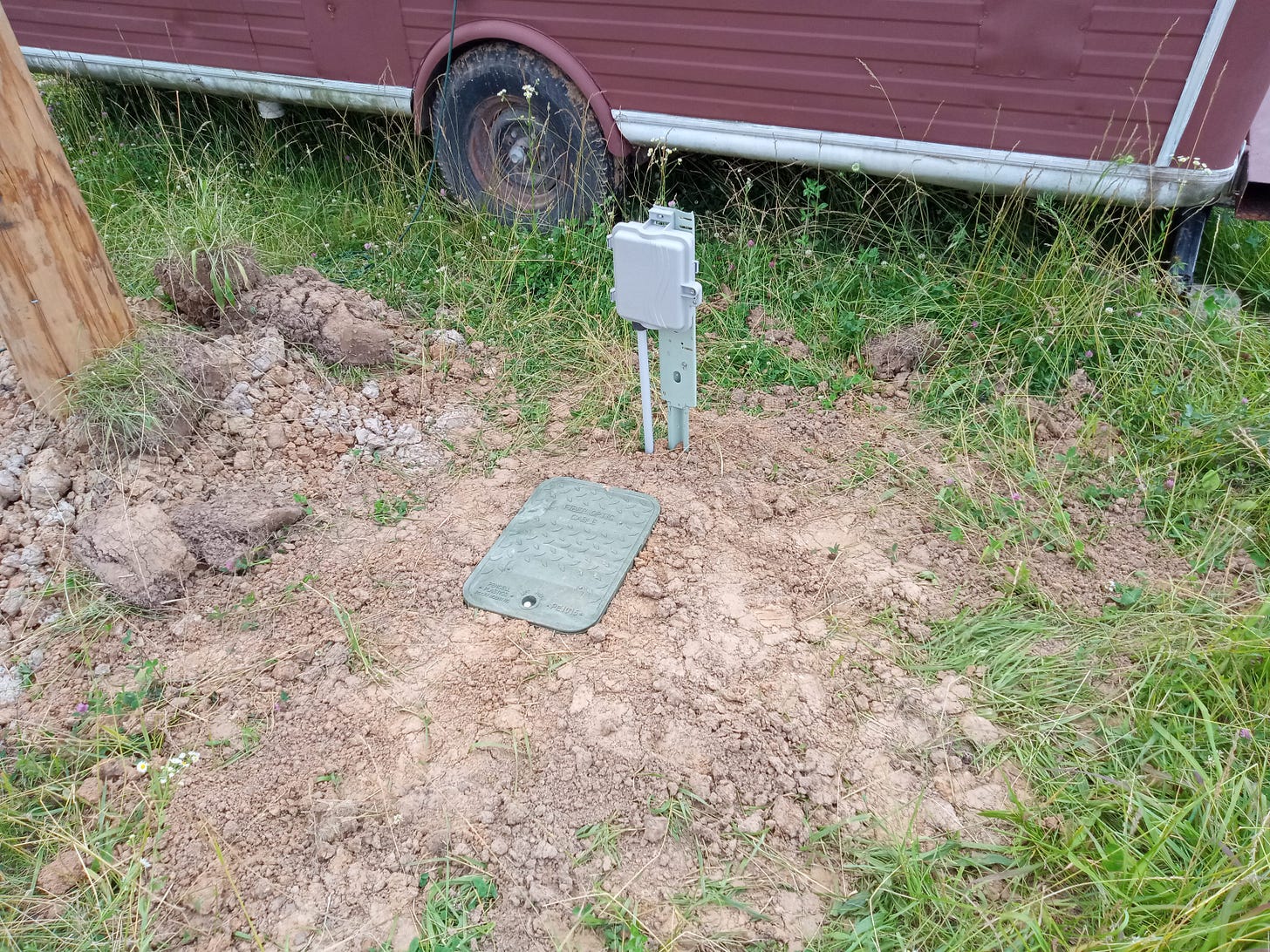Calving Delights, Homestead Builds, Writing Craft Appears
A lull in calving now, despite the rains. Pushed the homestead along with a cabin move. And I discovered a new book on writing craft which clarifies earlier foundational works.
Hi,
Thanks again for being here and opening this. For being part of this community.
(Note: this is probably too long for email, and so may cut off. In such case, there’s a link at it’s end to read all the verbosity online…)
Too many emails? Too few? Go here to adjust your settings.
Farming News - Calving season continues. And annual processing gets closer.
Writing News - Dissecting classics continues, improving - and still dropping ebooks behind the paywall for paid subscribers.
Fiction News - Now we’re moving on the next chapter of a new serial, from Book One of Hooman Saga
Expectancy Factor - A new Nightingale classic essay
Homesteading library - getting started off-grid, or on.
Farming News
We’re still at 14 calves arrived. Here’s the seventh one.
Again, yellow tags are heifers. Naming this one is a challenge, but your suggestions are welcome. Just reply to this newsletter, or leave a comment in the Substack app.
There’s a mystery with this one that will have to wait until next week - this calf is intimately connected to the next one…
We got big prices for those two bull-calves last week. They topped out anything we’ve sent to date. About three times what we usually expected for yearling bull calves. Prices are high right now, which helps the farm —since our own input costs have kept fairly low. Those two bulls paid for most of our hay this next year. (Usually, it takes about six calves to cover that cost.)
The whole herd got out one day - and two neighbors plus our mail deliverer told me. Fortunately, I’d already discovered these on my own. They made quite a parade across the the next-door soybeans. The tall grass and low-hanging trees made ample forage. It took me four hours to get them back in, because the wouldn’t herd until they got full and were ready to return.
Tiny Homesteading Progress
Moved the Writing Cabin up to the home site. This is going temporarily by the power pole to act as a home for the fiber-optic Internet and its wireless modem. Those are the three utilities we’ll have - water, power, Internet.
(I haven’t found any way to make a trailer by a power pole look nice. At least it’s there now - another step forward.)
Another forward step - a ground “vault” for the fiber-optic Internet drop:
Soon we’ll have that installed here, right after splicing it in to the mains.
I need to continue removing all that old wood from the frame, salvaging what we can - for later upcycling as possible (even as firewood.) And then start in on the subfloor.
I’ve begun hauling my tools to the site, as well as supplies. Meanwhile, my wife has begun looking for discounted cabinets and other outfitting items.
Once the subfloor is set into perfect shape, then we’ll be ready for the build itself - which will be six-weeks waiting period out from there.
And I may clean up a third tiny-home project — a pickup camper refitted onto a dual-wheel trailer — for resale as a hunting cabin. It’s got some niceties like built-in A/C, propane stove, refrigerator, and on board water tank - way too much for me to refit. Some minor cosmetic fixes and a deck on that trailer, the it will be good for a new owner - and free up those funds for our homestead build.
We’ll soon be able to move our cottage up to the site (hopefully, the nearby pond work will be done by then) and I’ll then have the luxury of being able to simply step out in the morning and go to work on our new home, just footsteps away. Which means my wife can come out on the porch to call me to dinner.
Again there are bills to this, even while my labor is one of love. It will take just under $30,000 to build this 20x48 foot tiny home - then we’ll start outfitting. Which will require additional funds. It’s just under 960 square feet. All bulidng with on our retiree incomes, plus my book sales. Yes, that’s a real trick. While I’m working to improve my book marketing and sales, your donations are welcome. It’s another way to join this adventure and journey.
This “buy me a coffee” link works for probably any amount…
A Point About Off-Grid
I finally got around to collecting and publishing my notes on this:
Off-grid homesteading basics:
(A long Note.)
First, get yourself a Post Office Box. To get an address, counties in this area assume you’re putting a primary residence there, one that is going to need power and septic systems, and 911 location. Pick up your mail weekly. Off-grid means off any grid.
Second, don’t get a power line run in. Use Solar, and minimize your electrical dependency. Use power-saving DC lights and USB charging for your laptop and cellphone. Don’t use electric-powered anything else that requires the mains. Especially heat and A/C, washer-dryers, etc. You can always add on more panels and upgrade your solar system. Start small to avoid breaking your budget.
Third, bone up on water collection and purification. Metal roofs (non-rusty) are premium collectors. Funnel their rain catchment into cistern setups. Filter this water for consumption. Use any grey water for irrigation (meaning: biodegradable soaps.) Most plants love phosphates. There are solar-powered water heaters. Water pulled from tanks below frost levels will be somewhere around 40-50 degrees all year round. And there are wood stoves with water-heating tanks. Compute in how much composting of your personal waste (night soil) will be needed, and how to do this safely.
Fourth, build tiny. You don’t need that much space. Pioneers and returning WWII vets raised families in a few hundred square-foot homes. And enjoyed the outdoors more. RV’s often have more than you need, such as expensive A/C. Smaller areas are less expensive to heat and cool. An R/V with good insulation under a white-topped carport as a second roof will reflect a great deal of heat.
Caveat: render unto Caesar according to regulations. But the key point seems to be “having a principle residence” somewhere. In our county, RV’s aren’t regulated. But you can’t get the electric grid to a small acreage without some permanent building with a concrete pad. However, a seasonal hunting cabin with solar power and a composting toilet is perfectly acceptable. And a few loads of gravel for a driveway is a lot less expensive than digging in a permanent water and septic system.
Again, “off-grid” means off any grid. Self-reliant, sustainable.
Again - consult your authorities. This is not legal advice, but things I’ve observed. Your mileage may vary.
We’re already through half our budget without building the house proper itself.
I had an uncle whose only legal address was a P.O. box in a state with no personal property tax. And lived out an RV all year round - with his wife and a dog. South for the winter, North for the summer.
And I confirmed this with our “pond guy”: if you don’t want government intruding on your rural lifestyle, don’t ask for an address for that property. Be prepared to be self-reliant.
Writing News
[Still needing to get print proofs for that pentalogy of books (my five Writerpreneur books). I keep this sentence here to remind myself.]
Dissecting L’Amour’s “Gift of Cochise’ work is moving along. We covered scenes 12, 11, and 10 of his short story this week, aligning it to the fourth lesson in the “Keep ‘Em Reading” section of the Forgotten Bestseller Secrets book.
Now we are studying scenes and their sequels. A big subject. Again, studying by dissection enables you to shorten your learning curve, by learning from the polished published works of the Masters.
We’ll soon be able to continue our dissection through the Hondo book, chapter by chapter, and aligning these lessons currently being released (ones on Compelling Characters and Riveting Storytelling.) We are building a simple three-part training program for authors. And it’s both an adventure and a journey. Right here in these newsletters (or live on the Substack app.)
All to shorten our writer-craft learning curve and increase our income from book and story sales. Yes, I’m on this same ride along with you.
Writing Craft Discovered
During the work on distilling Louis L’Amour’s “Gift of Cochise”, I’ve been reviewing how the Campbell’s original writing craft had evolved. I chased the course through his successors (Foster-Harris, then Dwight V. Swain, followed by Jack Bickham, and now Deborah Chester) to find that his original material has mostly survived. Chester’s mentoring of Jim Butcher (of Dresden Files fame) tested her mastery of the subject and proved that the classic technical devices survive independently across time.
It really all goes back to Campbell’s insistence on studying the classics to master your own writing craft and personalize it.
That is the study-trail which shortens any author’s journey to success. Much as painters have always populated museums to copy and perfect their craft by duplicating the Old Masters, stroke by stroke.
I used to consider that successful authors who coincidentally wrote texts about their ideas of writing craft were the key books to collect and study, I now understand that those who taught after successfully publishing their own books, then wrote a text based on their refining experiences as an instructor — those now are the top flight books to assemble and internalize. And there is a string of them through the OU program which gives any author a proved training route.
I’m currently in the middle of digesting both Bickham’s and Chester’s books, comparing theirs against Campbell, Harris and Swain.
Just so you know how I’m filling my copious free time.
Book Marketing News
Out of a note I posted recently:
Effective book marketing has core essentials:
First -
Create and hold a clear vision
Then -
Build a clear offer
Show up consistently
Build your community - collaborate widely
And -
Ask regularly
Keep refining your writing and marketing craft daily.
That first point, Vision, is out of key books such as Hill’s Think and Grow Rich, and Jones’ If You Can Count to Four. These are backed up by the books referenced in Nightingale’s Strangest Secret recording.
The Offer itself is seldom clear for most newsletters. And if they are struggling with subscriptions (especially the paid ones) then they haven’t narrowed down to what specific problem they uniquely solve for their readers.
Consistency is key in all business, all creative output. Writers have to build a consistent body of work by showing up regularly and putting in the work. This is how they are found. And how they excite readers to find more of their work.
Community is the missing link to all book sales. This is what the trad book editors call “platform”. When you build your audience of readers into a real community, then they will help each other. It’s no longer one reader against the world. You will have a team to lead, one that has your back.
Asking for the sale is another weak point of authors (myself included.) But you see how this works when you start implementing it. Again, you have to have a clear offer, and some kind of product they can buy that mirrors what your readers most want out of life.
Refining your craft has to be an always-on discipline. A life-habit. This is how you become a professional - one that makes a profession out of what they most like to do.
These give the core principles of marketing. Off hand, it seems to be that building community and regularly asking are the two critical flaws to book marketing success.
The other point is to build an always-on drive to improve writing craft. Louis L’Amour only late in his life considered that he was getting close to mastering his writing as a craft.
Many Irons in the Fire
I’m still collating and building TOC’s for my back list of materials. In other scraps of spare time. And I’ll get these added to my site with its own emphasis in the menu bar.
Yes, that book on sales I mentioned last week is on a near back-burner, as now is the Expectancy Factor book. And getting my paperbacks out. Again, priorities count.
At the bottom, below this, I start a foray into homesteading - with updating Maurice G. Kains’ Five Acres and Independence. (Attached below for paid subscribers.) This will probably expand into a homesteading starting-library - stay tuned.
I keep all these going by allotting time to these five newsletters. Tricky, somewhat - and it keeps me from collaborating as much as I’d like to.
With all I have on-going on the farm and in my Tiny Home construction, time seems tight. Focus on the vital things is key.
Still, I’m only here to help.
Also published this week (ICYMI):
Writerpreneur Lessons
Fiction Posts
Expectancy Posts
Pro Writing Lessons
Thanks for being there, opening this.
Sharing is caring. You’re who I do this all for. I value your input.
Leave a comment if something strikes your fancy.
I hope your life is not too interesting to be overwhelming, but sufficiently engaging to keep you amused. (Like some of us here...)
Robert
PS. Again, you can always email me about anything.
PPS. And you can always buy me a coffee…
Bonus:
The upcoming revision to Kains’ Five Acres and Independence. Buying this link directly ensures you can always update to the latest edition.
While paid subscribers have instant access to this ebook below:
Keep reading with a 7-day free trial
Subscribe to Writing While Farming to keep reading this post and get 7 days of free access to the full post archives.








![[Writerpreneur] Compelling Characters 04](https://substackcdn.com/image/fetch/$s_!iHFp!,w_140,h_140,c_fill,f_auto,q_auto:good,fl_progressive:steep,g_auto/https%3A%2F%2Fsubstack-post-media.s3.amazonaws.com%2Fpublic%2Fimages%2Ff285e4c8-0d82-4c0c-b3f4-7058dea8bd09_2900x1817.png)


![[Pro Writer] Hondo by Louis L'Amour - Dissection, Part 6](https://substackcdn.com/image/fetch/$s_!IIEb!,w_140,h_140,c_fill,f_auto,q_auto:good,fl_progressive:steep,g_auto/https%3A%2F%2Fsubstack-post-media.s3.amazonaws.com%2Fpublic%2Fimages%2F7844bf2e-2db3-479d-86a3-11705f7f16f1_1600x1100.jpeg)
